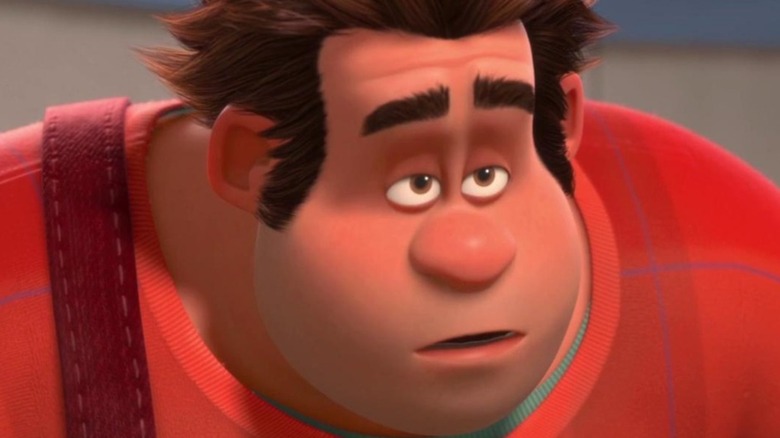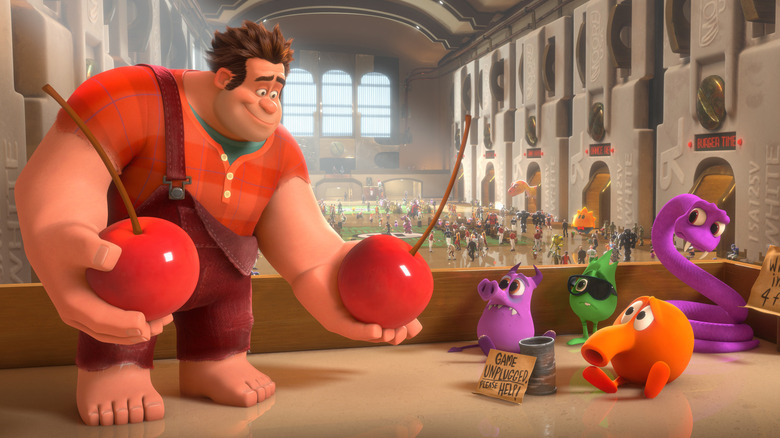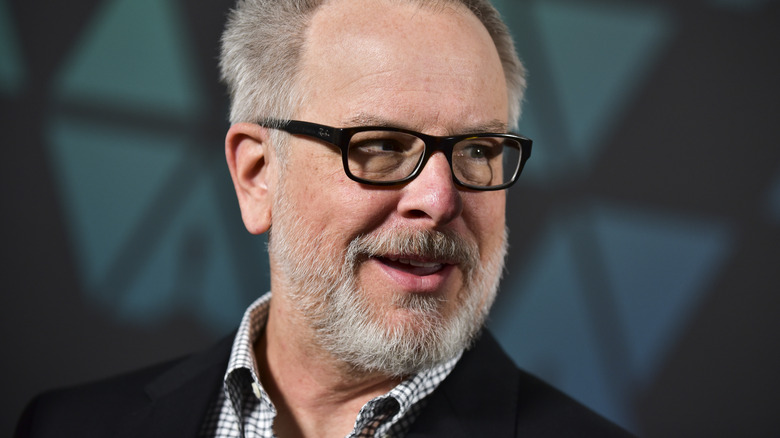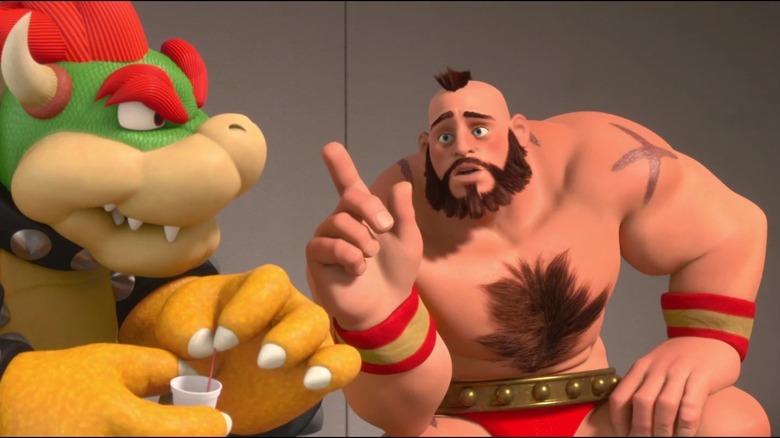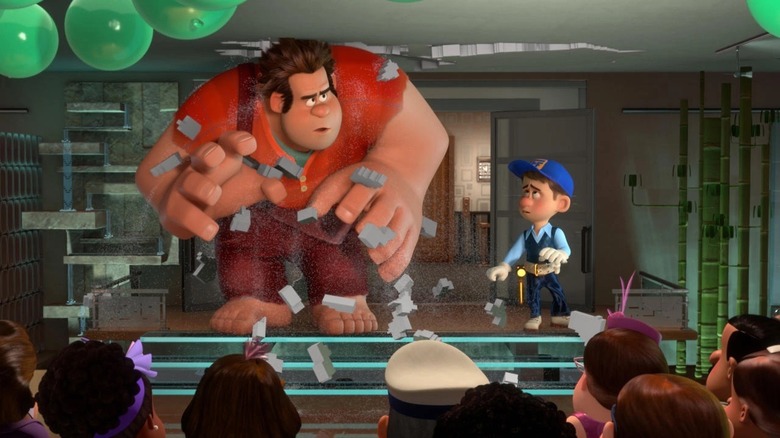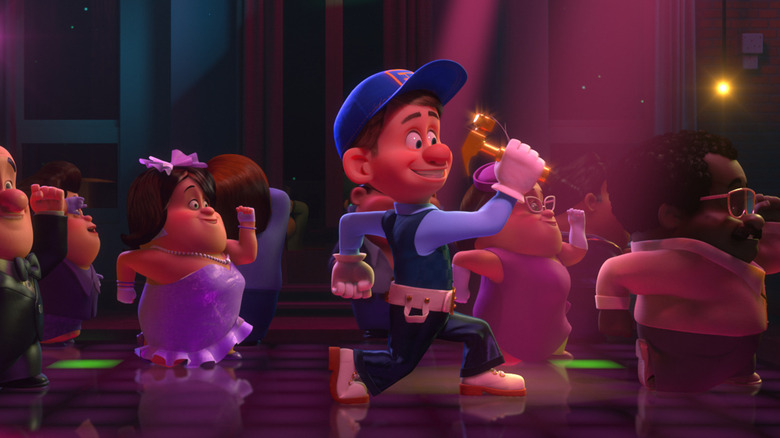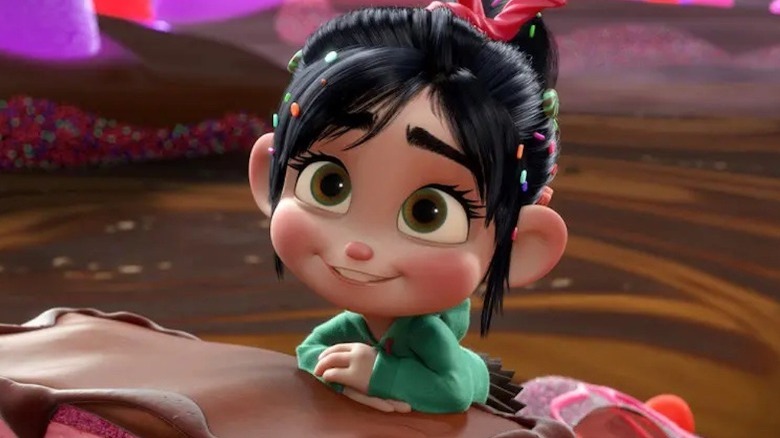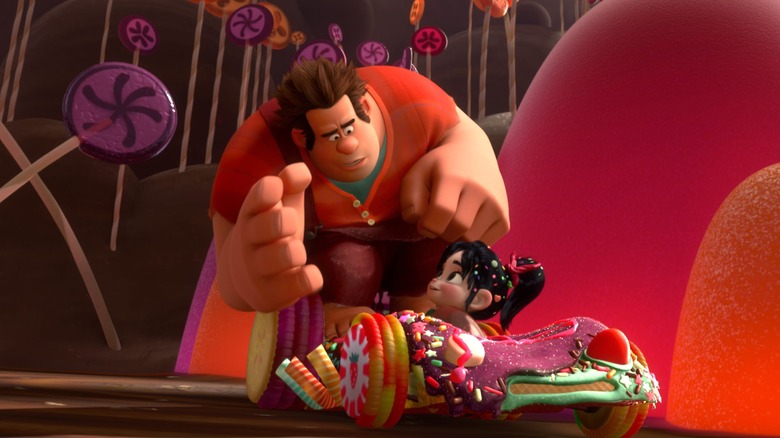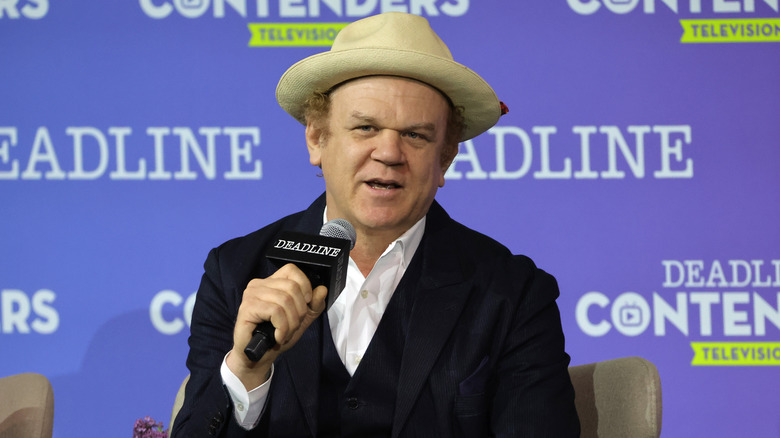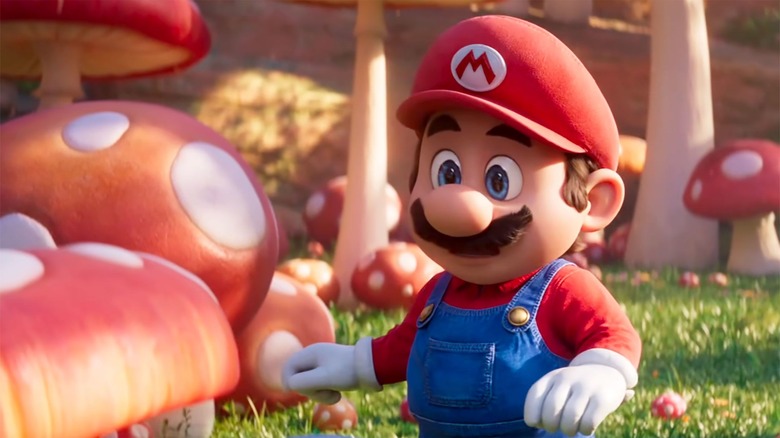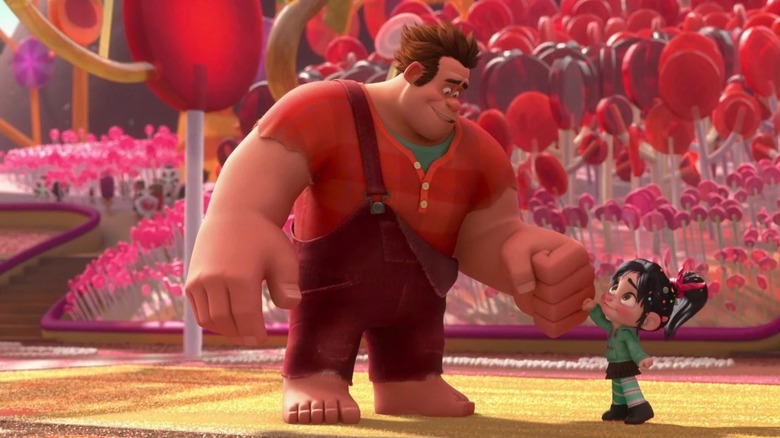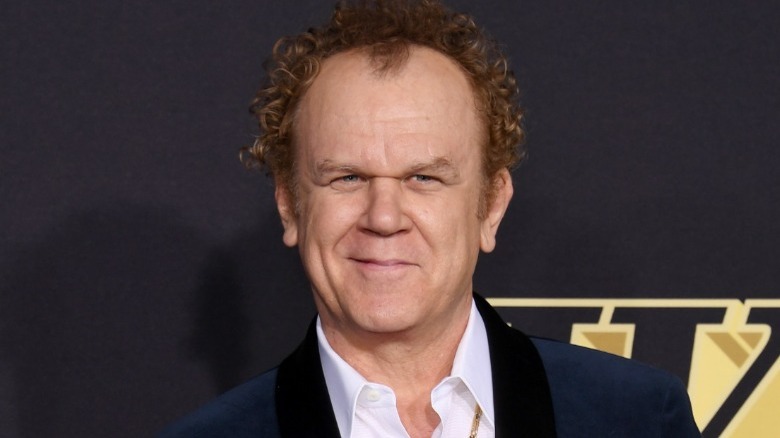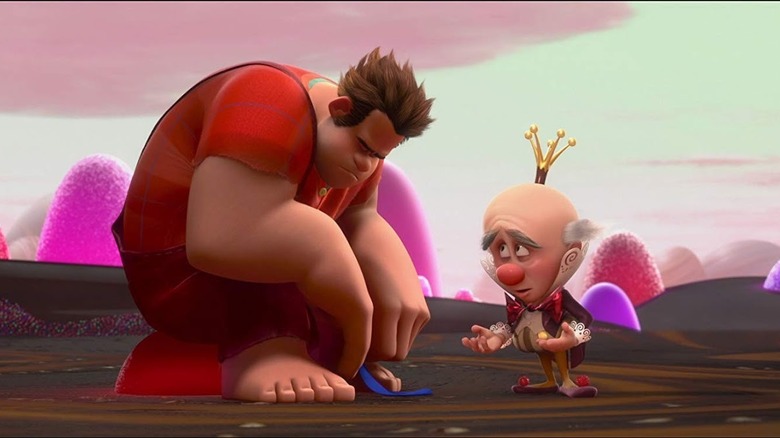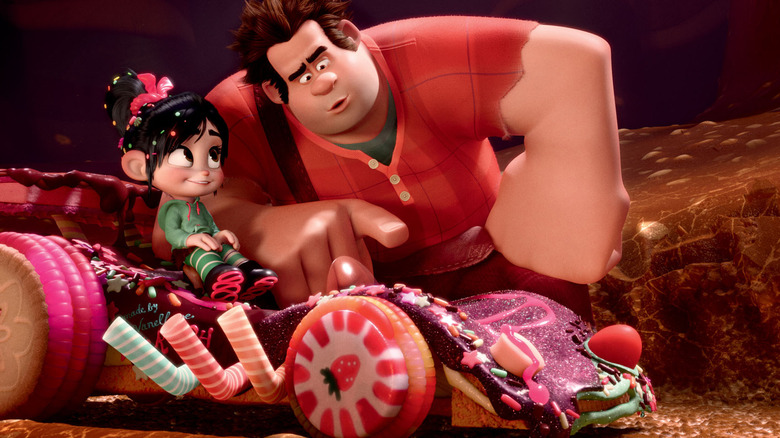These Wreck-It Ralph Details Are Boss Level
Many of the most beloved Walt Disney Animation Studios features tap into something universally recognizable. These stories often involve magic, talking animals, and any number of other preposterous elements, but the most beloved Disney animated features also evoke incredibly relatable human experiences within the context of stylized animated storytelling. This trait is especially apparent in the studio's 2012 motion picture "Wreck-It Ralph." Taking place in a wide variety of heightened video game environments you could never find in the real world, its titular character's struggle to feel loved and appreciated is one that any audience member could relate to. You don't need to be living in an 8-bit arcade game to understand Wreck-It Ralph's struggle.
It's these grounded emotions that helped make "Wreck-It Ralph" such a massive hit with moviegoers. There are also some other aspects of this feature that played into the film's positive reception. Details like the consideration that went into the character design of Wreck-It Ralph, for example. There's Henry Jackman's thoughtful approach to the score, why John C. Reilly was cast to voice Ralph, and more, which all added up to create a movie that audiences found irresistible. Understanding these aspects of "Wreck-It Ralph" makes it more apparent than ever exactly how this motion picture was able to live up to the long legacy established by classic Walt Disney Animation Studios features.
The earlier versions of Wreck-It Ralph
Like many animated Disney titles, "Wreck-It Ralph" went through various incarnations before settling into its final form. An early version of the feature from the 1990s was called "High Score," but an especially notable iteration of "Wreck-It Ralph" was through the proposed movie "Joe Jump." Per animator Sandro Cleuzo, the film was being worked on around 2006 and was a passion project for its director Sam Levine. Levine's LinkedIn profile sheds a bit more concrete light on how long he worked on "Joe Jump," with this director claiming he was shepherding "Joe Jump" from 2005 to 2008.
That timetable presented by Levine is interesting since his final year on "Joe Jump," 2008, lines up with when Rich Moore joined Walt Disney Animation Studios. Shortly after joining the company, Moore would become fixated on the idea of a movie set in the video game world and made a fresh new feature, "Wreck-It Ralph," that was its own separate thing compared to "Joe Jump." Levine has never publicly commented on why "Joe Jump" didn't go forward, though Blue Sky Disney reported in 2009 that it was due to then-new Disney animation head John Lasseter wanting to focus on more classical Disney fare at the studio. Whatever the reason, these unrealized visions of what would become "Wreck-It Ralph" reflect the long road many Disney animation classics take to getting realized.
How director Rich Moore joined Wreck-It Ralph
Rich Moore's initial forays as a director were on some of the most famous animated TV shows of all time. This included programs like "The Simpsons," where he helmed beloved episodes like "Marge vs. the Monorail," as well as episodes of "Futurama" and "The Critic." However, Moore's talents as an artist wouldn't be contained to the small screen forever. With "Wreck-It Ralph," Moore helmed his first theatrical feature film. To boot, this project took him to Walt Disney Animation Studios, a company that produces motion pictures with a vastly different tone than the adult-skewing cartoons Moore was accustomed to working on.
In talking to Rotten Tomatoes, Moore revealed that he joined Disney in 2008, where he kicked off his tenure by preparing three different pitches for potential animated movies to then-head of the studio John Lasseter. While doing this, Moore discovered Disney's various attempts at making a movie about video game characters. Intrigued by this storyline, Moore decided to take the basic concept of exploring the interior life of a video game character without taking anything from prior incarnations of this idea. From here, he came up with the basic concept that would define "Wreck-It Ralph." He then presented it to Lasseter and the project was approved to move into production. With that development, Moore got to enter a new and exciting chapter in his prestigious career.
Using real video game characters
Before there was "Ready Player One" or "The LEGO Movie," "Wreck-It Ralph" was up on the big screen bringing together beloved characters audiences never thought they'd see interact. In the case of "Wreck-It Ralph," these characters were all from the wide world of video games and ranged wildly from old arcade favorites like Q-Bert to enduring modern icons like Sonic the Hedgehog. There was a lot of pressure behind getting all these cameos of such adored fictional characters just right, and that pressure wasn't lost on the people in charge of bringing "Wreck-It Ralph" to life.
Talking to IGN, Moore revealed that the use of recognizable video game characters in "Wreck-It Ralph" was extremely important to him since it would lend an extra air of authenticity to the whole movie. Artists at Disney were also recruited to write down their favorite video game characters to give Moore and company some ideas about who they should be looking for to make cameos in "Wreck-It Ralph." Despite all the attention paid to these cameos, Moore made sure to emphasize that they weren't supposed to be the point of "Wreck-It Ralph," with the film's standalone narrative and characters taking precedent above all else.
How Wreck-It Ralph's design evolved during production
The character design of the titular protagonist of "Wreck-It Ralph" is inspired. Ralph's size and gigantic fists make it clear why somebody would be intimidated by him, but he's also got expressive eyes, an adorable nose, and an endearing quality to his partially unbuttoned overalls that make his soft side equally apparent. Looking at him now, it's hard to imagine there ever being alternate routes for how Wreck-It Ralph could've looked. However, getting to his final appearance took plenty of trial and error, not to mention several creative dead ends in exploring just what a video game villain should look like.
Talking to Rotten Tomatoes, Moore commented on the fact that Ralph was originally meant to be a bear rather than a human. This might sound perplexing, but it does make sense given that Ralph is a pastiche of the enormous gorilla Donkey Kong. However, as the story for "Wreck-It Ralph" evolved, Moore and the other artists in the movie found themselves struggling to sell key emotional moments between Ralph and the other characters when he was a bear. To create more of a connection between Ralph and people like Vanellope in the story, the wise decision was to ditch the bear route and make to make him a human being instead.
Making a villain the main character
In the canon of Walt Disney Animation Studios films, you'll find plenty of protagonists who fit the bill of traditional heroes, like crooning princesses or dashing princes. "Wreck-It Ralph" goes against that grain by focusing on a video game baddie who spends his days tormenting people, and certainly not singing about his ambitions of visiting the wider world. The final cut of "Wreck-It Ralph" wrings a lot of great drama out of portraying Ralph as an underdog struggling to escape his seemingly inevitable fate of always being seen as a monster. However, writing a movie with this kind of protagonist wasn't an easy task.
Talking to Collider, Rich Moore said that the biggest difficulty in writing "Wreck-It Ralph" was creating a protagonist who could live up to the definition of being a villain, but also didn't alienate moviegoers with his wickedness. Moore credited John C. Reilly's vocal performance as Ralph for making the character work so well since this actor has an innately likable quality to his vocals. The writing also eventually developed to ensure that Ralph was a flawed bumbling figure, but not an irredeemable force of constant malice. Through such distinctive voice acting and very careful writing, "Wreck-It Ralph" could deliver a protagonist unlike any other in Disney animation.
The technological innovations of Wreck-It Ralph
"Wreck-It Ralph" provided many variations on standard Disney movies, but an especially historic way it departed from the norm was in its camerawork. As broken down by Animation World Network, "Wreck-It Ralph" was the first animated Disney title to utilize the Camera Capture system. In a nutshell, Camera Capture replicates the sensation of working with a live-action camera and creates a virtual world that animators can move around. If you move the camera to the right, the Camera Capture system will capture whatever's there in the fictional world on the right. It's a tremendous accomplishment that gives artists infinitely more flexibility in the kind of camerawork they can use to tell their stories.
Plus, utilizing this technology allows for an even greater level of interaction between the director and animators. "Now, we can put a director virtually into a set and he can look 360 degrees in every direction and get a sense of the scale and placement of everything within the scene," explained layout artist Terry Moews on the importance of Camera Capture technology. "He can plan shots. We can hand him this device and we can watch him visualize the scene. It used to be the other way around. They've always had to watch us. We were always their eyes and ears into the set." Now, the director can be more immersed than ever thanks to the wonders of the Camera Capture system.
The challenges of animating 8-bit characters
"Wreck-It Ralph" takes place across multiple video games made in different eras of history. It only makes sense, then, that there would be unique visual flourishes scattered across each realm the story explores. These different styles show the viewer that these games were made anywhere from the present to the 1980s. For the land of "Fix-It Felix," its roots as a 1980s game are apparent in how the denizens of this game often move in a very stilted manner, suggesting there are frames of animation missing between their movements. This is meant to reflect that these characters exist in an 8-bit world, compared to the more glossy and detailed environments and characters seen in something like "Sugar Rush."
Talking to Collider, Rich Moore noted that it was initially difficult to execute this concept of how the 8-bit characters would move and function to the Disney animation team. This concept was such a radical departure from the norms of what animators at the studio were accustomed to that it initially seemed foolhardy to even attempt it. But once the animators were able to start realizing Moore's vision on computers, everything clicked into place. The animators saw the potential behind this maneuver and embraced it. While Moore admitted it took a long time to come to that point, he was so thrilled with the final results of all the efforts of these animators.
The reasoning behind casting John C. Reilly
It's hard to imagine anyone needing to come up with a reason behind wanting John C. Reilly in your movie. He's such a beloved actor and capable of portraying so many different kinds of people. Having him on hand as a cast member would be a boon to any movie. But when it came to "Wreck-It Ralph," director Rich Moore had some very specific reasons for pursuing Reilly as the film's lead character.
Talking to Rotten Tomatoes, Moore said that Reilly was thought of as the ideal voice for Wreck-It Ralph from the earliest days of production. What really drew Moore to this performance was Reilly's extensive experience with comedy, but also his dramatic qualities as a performer. He wasn't just all gags all the time — there was a deep humanity resonating beneath his wit. Getting that kind of important mixture was critical to making Wreck-It Ralph work as a character and made it imperative to get Reilly signed on to voice him. Reilly managed to live up to Moore's expectations and then some, to the point that Moore noted how small details of Wreck-It Ralph's character design were inspired by Reilly.
Why Mario never appeared in Wreck-It Ralph
There's no shortage of recognizable video game characters scattered throughout the world of "Wreck-It Ralph." Q-Bert gets to be a prominent figure in the narrative while a meeting between video game baddies is practically cameo heaven for hardcore gamers. But there is one legendary figure in the world of video games that's absent from "Wreck-It Ralph": Mario. This plucky plumber has been a best-selling staple of gaming for decades now, yet he never shows up on-screen in "Wreck-It Ralph." However, his absence wasn't out of a lack of trying on the part of "Ralph's" filmmakers.
Talking to Game Informer, Rich Moore explained that he and the production crew created a great rapport with Nintendo through "Wreck-It Ralph's" production. The company was very excited about the prospect of Bowser showing up in a support group for video game villains and hoped the "Wreck-It Ralph" team could find a similarly perfect scene for Mario in the movie. Moore and his team worked hard to find a spot where Mario would fit into the movie's narrative, but they never found one that felt organic to this feature's narrative or worthy of a character as beloved as Mario. Rather than awkwardly shoehorn him into "Wreck-it Ralph," Moore decided to exhibit some restraint and not use Mario.
Henry Jackman's vision for Wreck-It Ralph's score
With "Wreck-It Ralph," composer Henry Jackman wasn't just tasked with creating a score for an animated family movie. He was also in charge of making a film score that could be simultaneously in touch with the vast world of video game music. Like so many other parts of "Wreck-It Ralph," Jackman's score would need to jostle between two different mediums of artistic expression. Jackman explained to the Los Angeles Times that realizing this creative vision meant doing research in the form of revisiting video games he'd loved in his youth. This wouldn't be just a trip down memory lane, though. He was now listening carefully to these games, taking in the subtle details of their scores so that he could mold the music of game worlds like "Fix-It Felix" properly.
Jackman's key to making the score of "Wreck-It Ralph" cohesive was using a theme for the film's titular character as a motif throughout the various compositions. Though it sounded drastically different at various points in this story, this tune created a sense of musical unity across "Wreck-It Ralph." Jackman also made sure to not just rip off the themes of video games like "Mario Kart." He also consciously restrained the overtly video game-influenced tracks later on in "Wreck-It Ralph's" story when the pathos-heavy moments became prominent. These and other great details guaranteed that Jackman's "Wreck-It Ralph" score could communicate affection for both video games and cinematic storytelling.
John C. Reilly's biggest challenge voicing Wreck-It Ralph
Given that John C. Reilly has done every kind of movie imaginable in his lengthy and impressive career, one wouldn't think there'd be much that could intimidate him as an actor. But, when it came time to record his lines as the titular lead of "Wreck-It Ralph," Reilly did find himself having to overcome some major challenges. This being his first major foray into the world of voice acting, Reilly had to grow accustomed to this style of acting without making his line readings sound like he was an actor adjusting to a new domain.
Talking to Collider, Reilly noted that one of the biggest hurdles in adjusting to voice acting was the lack of memorization of lines. With a script right in front of him at all times, Reilly was in a completely different world compared to the kind of acting he'd be required to do on a live-action movie set. While it was nice to have his lines around constantly, it also meant that Reilly needed to make sure his line deliveries came across as organic and not just as him reading words off a sheet of paper. Once he got around that and other obstacles, though, Reilly found the art of voice acting and especially getting to breathe life into Wreck-It Ralph an incredibly fulfilling experience.
The importance of Wreck-It Ralph's box office success
In 2010, Walt Disney Animation Studios came roaring back to life with the gargantuan box office haul of "Tangled." The impressive numbers signaled that things were turning around for the animation house, but Disney wasn't out of the woods yet. The jury was still out on whether or not "Tangled" represented a permanent turnaround for Disney animation at the box office, or if it was just an anomaly. The follow-up computer-animated project from the company, "Wreck-It Ralph," would be a pivotal test case on Disney's long-term box office stamina.
Thankfully for those at Disney, "Wreck-It Ralph" turned out to be a big enough hit to quell any worries about the company's box office capabilities. In its worldwide box office run, "Wreck-It Ralph" made just under $500 million while its domestic haul managed to reach $189 million. Its performance in North America was instantly impressive when it lifted off with the biggest opening weekend in history for a Walt Disney Animation Studios title in this territory. Unsurprisingly, such a massive bow ensured that "Ralph" wound up as one of the biggest Disney animation titles in history in this territory up to that point. As a cherry on top, "Ralph" landed as the 14th largest film of 2012 at the worldwide box office.
"Tangled" brought Walt Disney Animation Studios back as a box office juggernaut, but "Wreck-It Ralph" cemented that the studio was in a financial renaissance.
Rich Moore's pride over Wreck-It Ralph's success
There was a lot that Rich Moore could be proud of regarding "Wreck-It Ralph" after this movie struck a chord with audiences. But talking to Game Informer, Moore noted that his greatest source of pride was how "Wreck-It Ralph" resonated with moviegoers despite not being a traditional Disney film in many key ways. It wasn't based on a beloved storybook tale like "Snow White" or "Cinderella," and, in a massive departure from most Disney animation, there were no musical numbers to be found. It's easy to imagine an outcome where the absence of these staples of Disney features would've alienated audiences from even giving "Wreck-It Ralph" a shot.
Instead, audiences around the world flocked to "Wreck-It Ralph," as seen by its enormous box office haul. Moore attributed this to the pathos of "Wreck-It Ralph" as well as the compelling characters within its story, not to mention a fictional world that tickled the imaginations of moviegoers across all age groups. This would've been satisfying under any circumstances, but seeing all this happen with a movie that eschewed Disney animation norms was incredibly exciting to Moore. For him, "Wreck-It Ralph" expanded what audiences could expect and enjoy from a Walt Disney Animation Studios movie. No wonder Moore felt an extra sense of pride over "Wreck-It Ralph."
